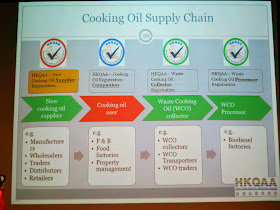The Seminar entitled "New Standard of Food Safety" (食品安全新標準) was organized by Hong Kong Quality Assurance Agency (HKQAA) on 26 Nov 2014. The seminar aimed to assist food industry understanding the new food safety standards/regulations and enhance food safety management through certification schemes. I took a photo with all guest speakers for memory.
(Left: Mr. Chan Tsz Chung (Lecturer, Dept. of Applied Science, HKiVE (Chai Wan)), Ms. Meico Cheong (Business Manager, HKQAA), Mr. Y.Y. Tsang (Food Safety Specialist, Food & Pharmaceutical Division, CMATCL) and I)
The first speaker was Ms. Meico Cheong (Business Manager, HKQAA) and her topic entitled “We are here to help”. In the beginning, she briefed some background of HKQAA and food safety related certifications included ISO 22000, HACCP, Hygiene Control Scheme (HCS) and 5S scheme.
Then she introduced ISO 22000, HACCP, and Hygiene Control Scheme (HCS). The comparison among schemes is summarized in the following table.
ISO 22000:2005 specifies requirements for a food safety management system where an organization in food chain needs to demonstrate its ability to control food safety hazards in order to ensure food is safe at the time of human consumption. The key elements included “interactive communication”, “system management”, “prerequisite programs”, “HACCP principles” to ensure food safety along the food chain, up to the point of final consumption.
There are 7 principles of HACCP below:
1) Conduct a hazard analysis (e.g. Biology/Chemical/Physical hazards)
2) Determine the Critical Control Points (CCPs)
3) Establish critical limit(s)
4) Establish a system to monitor control of the CCP
5) Establish the corrective action to be taken when monitoring indicates that a particular CCP is not under control
6) Establish producers for verification to confirm that the HACCP system is working effectively
7) Establish documentation
The implementation of HACCP system was shown in the following diagram.
HKQAA Hygiene Control Scheme (HCS) included “Management Responsibility”, “Relevant Hygiene criterion” (i.e. Operation process, environment, food processing and individuals) and “Monitoring system to verify the effectiveness”. HKQAA-HCS has 6 guidelines below:
1) Management commitment
2) Manipulated hygiene
3) Environment & hygiene
4) Storage and delivery of food
5) Personal hygiene
6) System’s monitoring, control and verification
The HCS scheme included on-site audit and lab test (unannounced). The test sampling based on the risk and samples included “Air quality, Ice and water, and Food”.
Lastly, Meico introduced the new scheme requirements named “HKQAA – Hong Kong Cooking Oil Registration Scheme”. It aims to promote good practices to the industry for the proper handling of new cooking oil (CO) and waste cooking oil (WCO); and to encourage registered participants to take the first step to provide cooking oil with identifiable sources and waste cooking oil handled with traceable records. The registration schemes are along cooking oil supply chain included supplier, Companion, Collector and Processor.
The second speaker was Mr. Y.Y. Tsang (Food Safety Specialist, Food & Pharmaceutical Division, CMATCL) and his topic named “Elaboration on the new Microbiological Guideline for Food”. Mr. Tsang mentioned about 80% food poisoning outbreaks caused by bacteria such as Salmonella (沙門氏菌屬), V. parahemolyticus (副溶血性弧菌) and C. perfringens (產氣莢膜梭狀芽孢桿菌).
Then Mr. Tsang introduced the 2014 Microbiological Guidelines for Food which was effective on 14 Aug 2014. It defined Microbiological Limits for ready-to-eat food in general and for 6 specific food items. The specific food included “Bottled Waters”, “Edible Ice”, “Non-bottled Drinks”, “Powdered Formulate for Infants and Young Children”, “Treated, Read-to-Eat Spices” and “Live/Raw Bivalve Molluscs Intended for Direct Consumption”.
After that Mr. Tsang briefed the microbiological limits on each type of food based on aerobic colony count (ACC). He added hygiene indicator organisms such as Enterobacteriacca and Escherichia coli which reflect the hygienic quality of food. Present of Enterobacteriacca indicates inadequate cooking or post-processing contamination. Present of Escherichia coli indicates faecal contamination.
The third speaker was Mr. Chan Tsz Chung (Lecturer, Dept. of Applied Science, HKiVE (Chai Wan)) and his presentation was “New Regulation on Pesticide Residues in Food”. Mr. Chan briefed the background of the Pesticide Residues in Food Regulation (Cap. 132CM) which was effective on 1 Aug 2014. It aims to protect public health and linked with international standard on Pesticide Residues in Food.
Mr. Chan said the key point is to establish Maximum Pesticide Residues Limits for specific food commodities based on relevant food subgroup or food group under the food classification scheme of the Codex Alimentarius Commission (Codex). Then he introduced Acute reference dose (ARfD) and acceptable daily intake (ADI) which based on toxicology. ADI unit is mg/kg indicating mg of chemical / kg of human body. ARfD unit is also mg/kg but it indicates mg of chemical / kg of food. Example of pesticide maximum residue limits (MRLs) /extraneous maximum residue limits (EMRLs) on rice was showed.
Reference:
HKQAA - http://www.hkqaa.org
The kick-off ceremony of the Hong Kong Cooking Oil Registration Scheme
2014 Microbiological Guidelines for Food
Pesticide Residues in Food Regulation
CAP 132CM Pesticide Residues in Food Regulation











沒有留言:
發佈留言